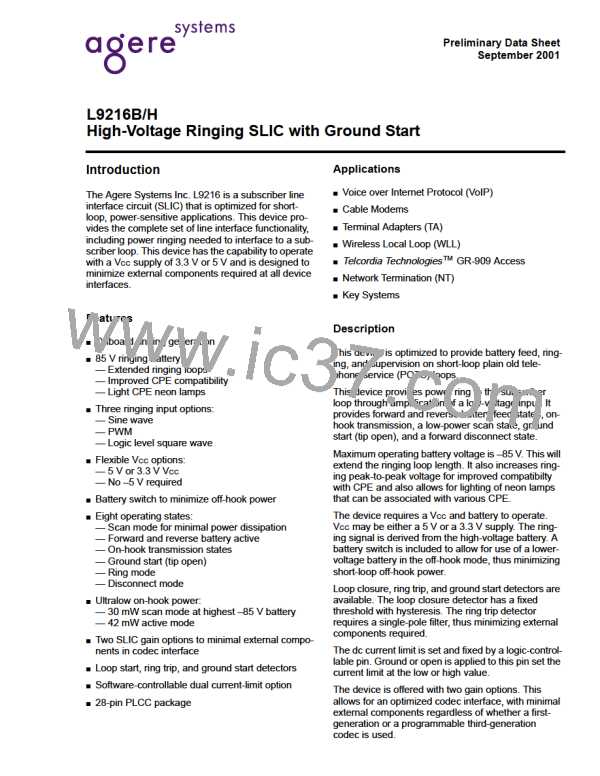L9216B/H
Preliminary Data Sheet
September 2001
High-Voltage Ringing SLIC with Ground Start
Note also that some third-generation codecs require
the designer to provide an inherent resistive termina-
tion via external networks. The codec will then provide
gain shaping, as a function of frequency, to meet the
return loss requirements. This feedback will increase
the signal at the codec input and increase the likeli-
hood that a resistor divider is needed in the transmit
direction. Further stability issues may add external
components or excessive ground plane requirements
to the design.
ac Applications (continued)
ac Interface Network (continued)
With a first-generation codec, the termination imped-
ance is set by providing gain shaping through a feed-
back network from the SLIC VITR output to the SLIC
RCVN/RCVP inputs. The L9216 provides a transcon-
ductance from T/R to VITR in the transmit direction and
a single-ended to differential gain from either RCVN or
RCVP to T/R in the receive direction. Assuming a short
from VITR to RCVN or RCVP, the maximum imped-
ance that is seen looking into the SLIC is the product of
the SLIC transconductance multiplied by the SLIC
receive gain, plus the protection resistors. The various
specified termination impedances can range over the
voiceband as low as 300 Ω up to over 1000 Ω. Thus, if
the SLIC gains are too low, it will be impossible to syn-
thesize the higher termination impedances. Further, the
termination that is achieved will be far less than what is
calculated by assuming a short for SLIC output to SLIC
input. In the receive direction, in order to control echo,
the gain is typically a loss, which requires a loss net-
work at the SLIC RCVN/RCVP inputs, which will
reduce the amount of gain that is available for termina-
tion impedance. For this reason, a high-gain SLIC is
required with a first-generation codec.
In the receive direction, the issue is to optimize the
S/N. Again, the designer must consider all the consid-
ered TLPs. The idea, for all desired TLPs, is to run the
codec at or as close as possible to its maximum output
signal, to optimize the S/N. Remember, noise floor is
constant, so the hotter the signal from the codec, the
better the S/N. The problem is if the codec is feeding a
high gain SLIC, either an external resistor divider is
needed to knock the gain down to meet the TLP
requirements, or the codec is not operated near maxi-
mum signal levels, thus compromising the S/N.
Thus, it appears that the solution is to have a SLIC with
a low gain, especially in the receive direction. This will
allow the codec to operate near its maximum output
signal (to optimize S/N), without an external resistor
divider (to minimize cost).
To meet the unique requirements of both types of
codecs, the L9216 offers two receive gain choices.
These receive gains are mask-programmable at the
factory and are offered as two different code variations.
For interface with a first-generation codec, the L9216 is
offered with a receive gain of 8. For interface with a
third-generation codec, the L9216 is offered with a
receive gain of 2. In either case, the transconductance
in the transmit direction or the transmit gain is 300 Ω.
With a third-generation codec, the line card designer
has different concerns. To design the ac interface, the
designer must first decide upon all termination imped-
ance, hybrid balances, and transmission level point
(TLP) requirements that the line card must meet. In the
transmit direction, the only concern is that the SLIC
does not provide a signal that is too hot and overloads
the codec input. Thus, for the highest TLP that is being
designed to, given the SLIC gain, the designer, as a
function of voiceband frequency, must ensure the
codec is not overloaded. With a given TLP and a given
SLIC gain, if the signal will cause a codec overload, the
designer must insert some sort of loss, typically a resis-
tor divider, between the SLIC output and codec input.
These receive gain options afford the designer the flex-
ibility to maximize performance and minimize external
components, regardless of the type of codec chosen.
32
Agere Systems Inc.

 ZARLINK [ ZARLINK SEMICONDUCTOR INC ]
ZARLINK [ ZARLINK SEMICONDUCTOR INC ]